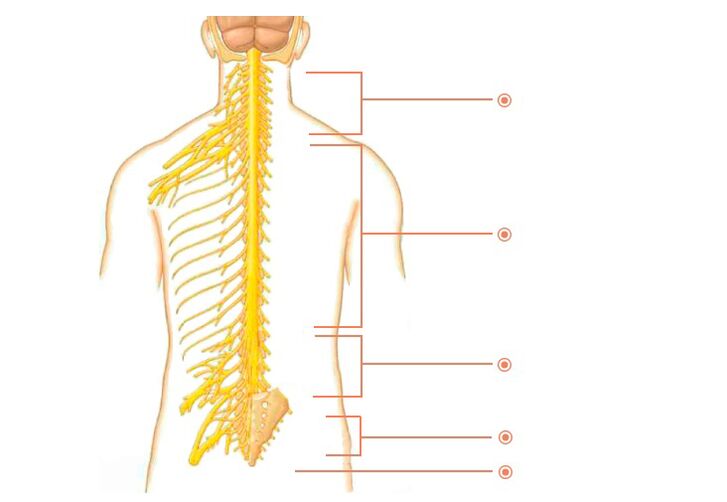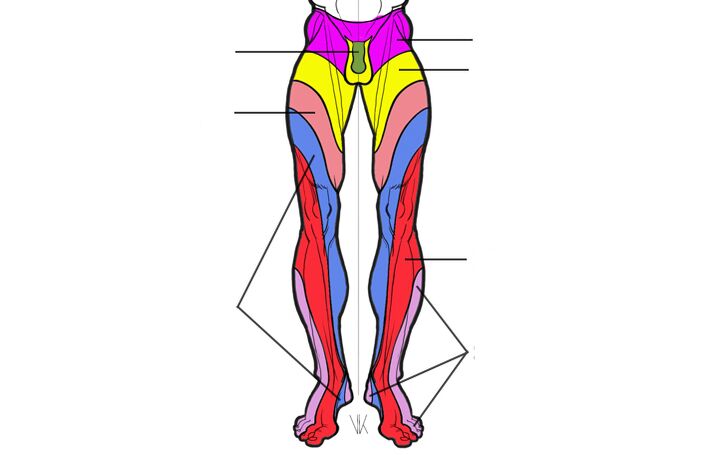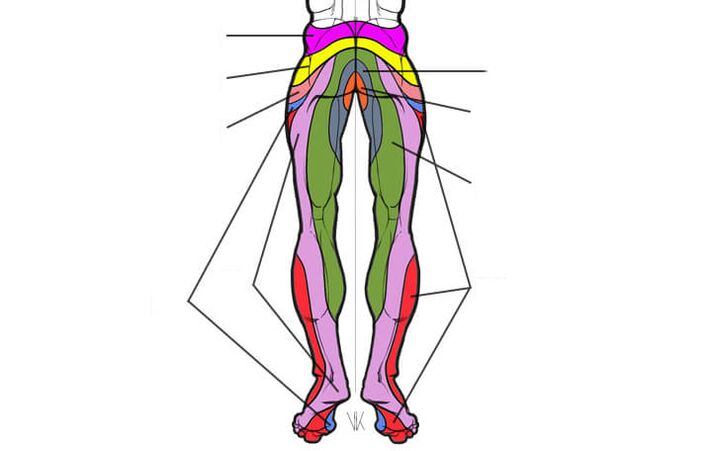Lumbar osteochondrosis is a degenerative disease of the vertebrae and discs. It is generally accepted that lumbar osteochondrosis affects both the spine itself and the nerves and blood vessels. Therefore, the symptoms of osteochondrosis of the lumbar spine are divided into those that affect the spine itself - they are called the vertebral / vertebral syndrome - and those that appear outside the spine, with the participation of nerve and vascular structures - are called non-vertebral / extravertebral syndrome. The extravertebral, in turn, is divided into reflex and radicular syndromes. Since the word "syndrome" implies a group of symptoms, it can be simplified and stated that the symptoms of osteochondrosis of the lumbar spine consist of three groups: vertebral, reflex and radicular.
Vertebral symptoms of osteochondrosis of the lumbar spine
- Violation of the configuration of the spine (curvature);
- Tension of the muscles of the lower back;
- Violation of the mobility of the lower back;
- Localized back pain.
Reflex symptoms of lumbar osteochondrosis
The main reflex symptom is back pain. It can be abrupt or permanent. Pain occurs after physical activity or from awkward movements. For example, when turning, tilting or lifting weights. Muscle tension and stiffness of movement comes, most often in the morning. There are shots in the lower back or leg. Sensitivity of the lower limbs is impaired: numbness, goosebumps, piercing or burning. Changes in gait and coordination. Sweating increases. The work of the intestines and bladder is often disturbed. There are malfunctions in the work of internal organs. Sexual function suffers. Sleep is disturbed due to pain. Mood swings, irritability and fatigue appear. Sometimes there is depression.
Factors provoking an exacerbation are physical exertion, prolonged uncomfortable position, hypothermia, stress.
Symptoms of the pain reflex of osteochondrosis of the lumbar spine, depending on the severity and localization of the process, are usually divided into low back pain, low back pain and low back pain.
- Low back pain (low back pain)it is the most acute pain. A provocation is an awkward movement, sneezing, coughing. To alleviate his condition, the patient involuntarily leans forward or bends to the side. Attempts to straighten up cause new back pain.
- low back pain- "tolerable" aching pain, with episodes of exacerbation. Over time, it develops into intense, constant pain.
- Sciatica- Pain that extends from the lower back to the leg.
Radicular symptoms of lumbar osteochondrosis
They occur due to the effect on the nerves exiting the spine.
There are many nerves that come out of the spine. They are called spinal nerves. Each of these nerves gradually branches out and follows a certain area of the body with clearly defined boundaries. This area is called the segmental innervation zone. Each vertebra, disc, nerve and zone are numbered closely corresponding to each other. If the nerve is affected, the symptoms will appear in the segmental innervation zone corresponding to this nerve, and not just everywhere, in an arbitrary place.

spinal nerves
Radicular symptoms of lumbar spine osteochondrosis include:- decrease or loss of reflexes;
- muscle weakness;
- violation of sensitivity;
- root pain.
Not all parts of the lumbar spine are equally susceptible to pathology. The most mobile segments are most often affected: L3-L4, L4-L5 and L5-S1. According to the principle - "More movements - more wear".


Areas of innervation of the lumbar segments
Osteochondrosis L3 – L4- acts on the L4 spinal nerve. Main signs: weakness of the jerk knee. Pain, numbness, and reduced sensation disturb the front of the thigh.
Osteochondrosis L4 – L5- acts on the L5 spinal nerve. Main signs: Weakness in the muscles that lift the big toe and foot. It is difficult for the patient to stand on the heel. Pain, numbness and decreased sensation disturb from the lower back to the buttock and thigh "along the strip", then through the lower leg, gradually moving to the front and ending in the first three toes.
Osteochondrosis L5 – S1- acts on the spinal nerve S1. Main signs: weakness in the calf muscles. It is difficult for the patient to stand on tiptoe. Pain, numbness and decreased sensation are detected by the buttock, then along the back of the thigh and lower leg, moving to the side of the foot and little toe.
Sometimes, with lumbar osteochondrosis, not only the nerves but also the root arteries can be affected. This threatens the development of the most dangerous pathology - spinal stroke, with serious consequences for a person - paresis and paralysis, as well as severe malfunctions of the pelvic organs.
Symptoms of osteochondrosis of the lumbar spine:
- depend on the stage of osteochondrosis;
- aggravated by tilt and rotation;
- more often they appear after 30-35 years;
- women are about 3 times more likely than men.
You've obviously noticed that the root symptoms are clearly defined and the reflex symptoms are very vague and vague. And as you know, anything that doesn't have clear definitions serves as a convenient cover for professional impotence. This applies, among other things, to reflex symptoms and a concept so preferred by doctors as "age-related changes". Surely many of you are familiar with the situation where the doctor explained the problem with "reflex" or "age-related" processes. Most people in these moments rightly believe that the doctor simply cannot understand what is going on and is trying to veil his incompetence in the fog of these "magic words".
There was once a popular phrase: "Every accident has a name, surname and position". Each disease has its own unique symptoms. And the doctor's duty is to know them clearly. And then there will be no need to let the fog in and blame osteochondrosis of the cervical spine for everything. Now you understand how important it is to find an experienced and competent doctor. Both the correct diagnosis and the results of the treatment will depend on this.
When choosing a clinic, the main thing is to turn to an experienced and competent doctor.
Lumbar Osteochondrosis Diagnosis
To date, there are a number of modern methods of hardware diagnostics of osteochondrosis. The most accurate of these are MRI and CT. But the main method is still clinical diagnostics - this is when an experienced doctor compares data from at least three sources - from patient complaints, MRI results and symptoms that were revealed by him during the examination. This allows you to make the most accurate diagnosis and create an effective individual treatment program.
Treatment of lumbar osteochondrosis
As you understand, osteochondrosis is a real "tangle" of symptoms, extricating yourself, the doctor will save you from pain and anguish. But it is not possible to eliminate changes in the vertebrae and discs. Therefore, the words "treatment of osteochondrosis" must be understood correctly. If you are interested in eliminating pain and other suffering, then yes, it is entirely possible. And if you conduct an academic discussion on the subject of returning the vertebrae and discs to their original, "like a newborn" appearance, then no, the past cannot be returned. You have to be realistic and then you will not fall for the scammers.
Don't fall into the lure of scammers!
It is impossible to restore the vertebrae and discs to their original appearance!
What is the main treatment method?
Soft manual therapy is the main type of treatment for osteochondrosis of the lumbar spine. It's like an antibiotic for pneumonia - you can't do without it. Other types - massages, medicines, physiotherapy and physical therapy - are auxiliary.
How does gentle manual therapy work?
Disc nutrition is directly related to the muscles surrounding the lumbar vertebrae. Furthermore, the lower back muscles themselves are one of the constitutive causes of pain in lumbar osteochondrosis. Soft manual therapy is a special method that allows you to restore muscles to their natural physiology, eliminate spasms, muscle clamps and improve disc nutrition.
The intervertebral discs are the only part of the body that has no blood vessels and is nourished by the proper functioning of the muscles.
Also, when dealing with the help of the hands, the chiropractor:
- remove the load from the affected vertebrae and discs and distribute it correctly
- relax your muscles and help them return to normal
Thereby:
Manual impact mobilizes the internal forces of the body and initiates self-healing mechanisms. The treatment is absolutely safe.
The clinic uses all methods of soft manual therapy:
- release the patient from the clamps
- improve engine power
- restore the motor functions of the body
normalizes blood circulation
The qualification of doctors of any professional clinic allows you to freely use all these methods for the treatment of osteochondrosis of the cervical spine. Moreover, in each case, we combine them, taking into account the synergistic effect.
Synergy is not just an accumulation of different influences, it is the correct sequence in the combination of methods. The synergy leads to an additional quality of treatment. A simple example of synergy are our hands. How long does it take to fasten a button? Seconds? ! And if you do it with one hand, you can't handle it in a minute. That is, to act with two hands not twice as fast as one, but several times faster. And listening to the same music performed by individual instruments or the whole orchestra together - is there a difference? This is the effect of synergy: it allows you to do everything much more powerfully, more efficiently and faster, but at the same time with more attention.
Complementary therapies - medication, massage, physiotherapy and physical therapy
Treatment with drugs.In the treatment of lumbar osteochondrosis, drugs with various spectra of action are used. These are drugs that relieve deep tissue swelling, inflammation and pain. Drugs that improve blood circulation. In addition, drugs are used that help restore damaged cartilage tissue of the disc and pinched nerves: chondroprotectors and vitamins of group B. Taking drugs, in combination with other methods of treatment, if necessary, is prescribed by a chiropractor.
Massage.As you know, there is massage for pleasure and massage for healing. Pleasure massage is performed in the spa and treatment massage is performed in medical clinics. In the clinic, medical massage is performed during a gentle manual therapy session. To increase the effectiveness of manual treatment and normalize metabolic processes, all this can be a therapeutic massage!
Physiotherapy.There are many physiotherapy methods that help manual therapy in the treatment of lumbar osteochondrosis, for example, treatment with ultrasound, electrophoresis, laser, etc. A specific recommendation will be given by the chiropractor present.
Physiotherapy- involves regular gymnastics to strengthen the muscles. The main thing is to perform the right exercises without sudden movements. During the treatment in a specialized clinic, the doctor will advise you on the necessary exercises. Pilates is the best option.
Prevention of lumbar osteochondrosis
To avoid relapses, create comfortable conditions for sleeping and working. Watch your weight and proper nutrition. Maintain your physical activity. But the main thing is not to neglect your health and not to spare us. Don't let things go by themselves. After recovery, try to do at least one gentle manual therapy maintenance session once every three to six months - this will reduce your risk factors. Do not forget that neglected osteochondrosis leads to complications: protrusion and herniated disc. Remember: your health, first of all, you need!
Performing osteochondrosis leads to complications: protrusion and herniated disc.
Advantages of treating osteochondrosis in a specialized clinic:
- Guarantee of a complete and qualified treatment. The word "complete" is fundamental in our work.
- We consider each case individually and comprehensively - no formalism.
- Synergistic effect.
- Guaranteed honesty and fair prices.
















































